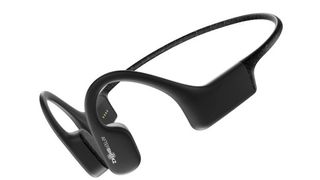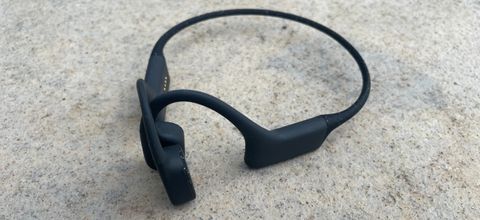Our Verdict
The MP3 playback on the Shokz OpenSwim bone conduction headphones makes them great for swimmers and people who don't carry a phone when they exercise, but they are expensive for a niche product.
For
- MP3 storage
- Waterproof
- Open design for awareness
Against
- No Bluetooth playback
- Battery life often shorter than listed
You can trust Coach
The Shokz OpenSwim MP3 headphones (previously called AfterShokz Xtrainerz) are designed for a niche within a niche. Not only are they bone-conduction headphones, which offer more awareness of surroundings but weaker sound than most of the best workout headphones and best running headphones on the market, but they also don’t connect to your phone or other devices. Everything you want to listen to on the OpenSwim has to be loaded on to them from your computer via the charging case.
Once your desired audio is loaded, however, the OpenSwim become a truly unique accessory. Runners who enter a lot of races and regular swimmers may well find that there are no other headphones that meet their needs so perfectly.
For runners who race, not having to carry a phone to listen to music lightens the load in your running belt. More importantly, the OpenSwim will also be allowed in many more races than standard headphones owing to the open-ear design, which allows you to hear instructions from race marshals and listen out for traffic when you’re not on a closed-road course. In fact, Shokz has a partnership with UK Athletics that means its earphones are the only ones approved for use in all road races under the UK Athletics Rules of Competition.

For swimmers (and watersports enthusiasts), the benefits are even more obvious, because you can’t (or at least are strongly advised not to) take your phone into the water. The Xtrainerz are IP68-rated, so they can withstand submersion in up to two metres of water (including salt water) for up to two hours.
They also sound impressive in the water, as long as you use the dedicated EQ setting, which takes the bass down several notches – sound travels well underwater so you don’t need much bass for it to boom. You may find that you’re slightly unimpressed by the sound before you actually stick your head under the surface but when you do, it comes to life. The difference is a little like being outside a club and then stepping inside. Or, if you’re a fan of Harry Potter, remember that bit in Harry Potter And The Goblet Of Fire when Harry listened to the big golden egg underwater and the merpeople’s song became crystal clear? Like that.
This does of course mean breaststroke gets a bit annoying with the bass cutting in and out as your head bobs in out of the water. When swimming backstroke and freestyle, however, the sound was continuously fine; even when you’re turning your head to breathe, it seems you only need one pad in the water for the effect to work.
It takes a little bit of arranging to get the OpenSwim to sit comfortably with a swimming cap and goggles on, but once you’ve sorted it they don’t move during the swim. If you’re going for an especially leisurely swim you won’t need to pin them down, but anything close to an aggressive push-off will dislodge them.
Other waterproof headphones/MP3 players that actually sit in the ear are less impressive on this front. Once the water has got into your ear it’s generally hard to get the buds to stay in place, so the relative security of the OpenSwim is a real plus.
The controls on the headphones are a little fiddly at first, and it’s definitely worth having the instruction manual to hand when you’re first using them. There are four buttons – a mode button that can change the headphones to swimming mode or set your music to shuffle or repeat – plus the usual volume up/down and multifunction button.
The OpenSwim have 4GB of space and you can add your audio to the headphones in folders to switch between collections when exercising. I set up one folder as my running playlist, another contained a series of a podcast, and so on. One downside is that you can’t switch from a podcast to music in another folder, then return to the podcast and pick up where you left off. It starts the folder from the beginning and while there’s a button combination to skip to the next track there’s no option to fast-forward. I’ll accept it’s a fairly petty complaint, but it speaks to the fact that for everyday use the OpenSwim are naturally more fiddly than headphones that link to your phone – and that’s before you take into account dragging and dropping audio files into folders. However, in certain situations the OpenSwim absolutely come into their own: if you’re a runner who doesn’t enjoy carrying your phone with you or a swimmer bored with endless entertainment-free lengths, they’re a novel and effective solution.
The price of £139.95 might be a sticking point, however. You can get a top-notch set of Bluetooth wireless headphones for that, like the Jaybird Tarah Pro, or a Bluetooth set of Shokz bone-conducting headphones like the Air. Whether they’re worth your money depends on how squarely you fit into the OpenSwim’s niche.

Nick Harris-Fry is a journalist who has been covering health and fitness since 2015. Nick is an avid runner, covering 70-110km a week, which gives him ample opportunity to test a wide range of running shoes and running gear. He is also the chief tester for fitness trackers and running watches, treadmills and exercise bikes, and workout headphones.

